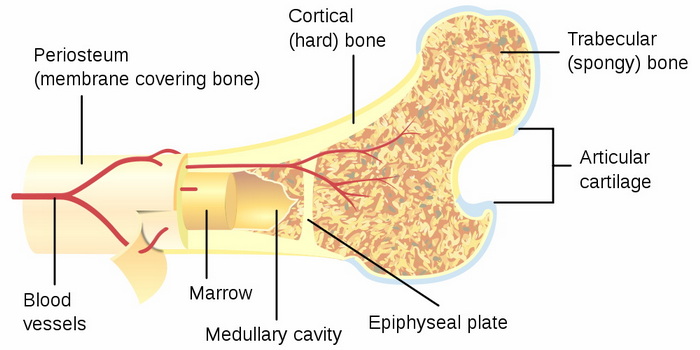Tuesday, April 20, 2021
Don’t be a bonehead and believe the endless Church of Darwin propaganda
How would a bone, or 206 of them in your body, ‘evolve’ to form a design?
by StFerdIII
Surprise, surprise, no bone evolution. How or why would the complexity of a bone, bone cells, and associated infrastructure (veins, capillaries, tendons, proteins, shape, function) ‘evolve’ over ‘millions of years’, to form a wonderfully designed and effective skeleton connected to the other systems of corpus, neurological and all the inter-related systems of movement and purpose? Is that story remotely plausible? Did the bacteria eventually ‘evolve’ arms, legs, bone structures for face, jaw, pelvis, feet, ankle, knee, shoulders, a rib cage and a spinal column ending in a coccus to name but a few fantastically designed structures? Did the building you are now in self form? Did the floors appear along with windows, glass, heating, a roof and running water? What good is a house without a roof? What purpose running water without end points such as a shower or faucet? How could thoughtful design self-create and even self-heal? Evolution, a non-science, has no scientific answers. Just conjecture and pretty pictures.

By Jerry Bergman
Bones are made of minerals built and maintained by cells. Bone osteocyte cells serve numerous roles in the vertebrate body, including bone remodelling to renew and repair bone, mechanical sensation, and mineral homeostasis.[2] The problem for evolution is, while the “developmental relationships of the four cell types (osteoprogenitor, osteoblasts, osteocytes, and osteoclasts) in modern bone are well known, very little is known about the evolutionary origins of these cells.”[3]
More than half of modern teleost (ray-finned, bony) fishes have acellular bone, called anosteocytic bone, which lacks osteocytes but employs the other bone cell types, namely osteoprogenitor, osteoblasts, and osteoclasts. Furthermore, much speculation about bone evolution exists: “bones may not have evolved, but theories of bone evolution certainly have.”[4] Thus, Wagner and Aspenberg, writing in 2011, quipped that if their article on bone evolution was “written a decade ago, it would have been considerably different” from one written today, due to the many different attempts to explain bone evolution based on speculation and just-so stories.[5]

Evolution requires that “this complex architecture of live and inorganic material must have emerged at some point in the course of evolution.” What should be found in this study of two bone examples, therefore, is evidence from less-complex design that progresses to more-complex design. The researchers compared a bone sample from Tremataspis mammillata, with a much younger sample from the fish Bothriolepis trautscholdi. The Tremataspis mammilla is a jawless fish that lived about 423 million years ago, belonging to the extinct Osteostraci group, and the Bothriolepis trautscholdi lived about 380 million years ago, belonging to the earliest group of jawed fishes, the Placodermi. What they found indicated the 400-million-year-old bones had an internal design far more complex than expected from evolutionary assumptions. Quoting the scientists involved in the research, they found that:
Even in the older sample of the jawless armored fish, the 3D images display a complex network with cavities (lacunae) for the bone cells and tiny channels through the bone interconnecting these cavities. “The channels are a thousand times narrower than a human hair and yet, amazingly, they have been almost completely preserved over these 400 million years” … Elaborate analysis of the high-resolution 3D images shows in detail how the network was constructed of cavities (lacunae) and the channels between them. “This proves that our early, still-jawless ancestors already possessed bones characterized by internal structure similar to ours and probably by many similar physiological capabilities as well.”[10]
Although this study used a new technique that requires repeating to validate the findings, so far no evidence was provided from the 3D scans that supports the gradualistic evolution of bone expected by Darwinism. Like all other attempts to document evidence of the evolution of bones from non-bone tissue, this study fails at this goal. So far, the evidence reveals that the first bone was a fully functional structure very similar to the two basic modern bone types. Note how this is expressed by evolutionists: “very little is known about the morphology of the first osteocytes, which is due to the inherent limitations of the fossil record.”[11]
References
[1] Yara Haridy, Markus Osenberg, André Hilger, Ingo Manke, Donald Davesne, Florian Witzmann. Bone metabolism and evolutionary origin of osteocytes: Novel application of FIB-SEM tomography. Science Advances 7(14):eabb9113 DOI: 10.1126/sciadv.abb9113, 31 March 2021, p. 1.
[2]Pascal R. Buenzli, and Natalie A. Sims, Quantifying the osteocyte network in the human skeleton, Bone 75, 144–150, June 2015.
[3] Haridy, et al., 2021, p. 1.
[4] Darja Obradovic Wagnar and Per Aspenberg, Where did bone come from? An overview of its evolution, Acta Orthopaedica 82(4):393–398, 2011.
[5] Darja and Aspenberg, 2011, p. 398.
[6] Alison H. Doherty, Cameron K. Ghalambor, and Seth W. Donahue, Evolutionary physiology of bone: Bone metabolism in changing environments, Physiology 30:17–29, 1 January 2015..
[7]Ron Shahar and Mason N. Dean, The enigmas of bone without osteocytes. BoneKEy Reports 2:343, May 2013.
[8] Science Daily. Insight into the evolution of bones: Modern biology considers bone cells (osteocytes) as essential for bone development and health, Science News, https://www.sciencedaily.com/releases/2021/03/210331143031.htm, 31 March 2021.
[9] Science Daily, 2021.
[10] Science Daily, 2021.
[11] Haridy, et al., 2021, p. 3.
[12] Bergman, Jerry. 2019. No Evidence for Bone Evolution, Creation Research Society Quarterly 56(1):17-25, Fall.